
A | B | C | D | E | F | G | H | CH | I | J | K | L | M | N | O | P | Q | R | S | T | U | V | W | X | Y | Z | 0 | 1 | 2 | 3 | 4 | 5 | 6 | 7 | 8 | 9
This article needs additional citations for verification. (March 2021) |
 |
| Part of a series on |
| Arab cuisine |
|---|
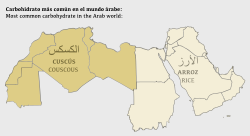
Arab cuisine is the cuisine of the Arab world, defined as the various regional cuisines of the Arab people, spanning from the Maghreb to the Mashriq.[1] These cuisines are centuries old and reflect the culture of trading in ingredients, spices, herbs, and commodities. The regions have many similarities, but also unique traditions. They have also been influenced by climate, cultivation, and mutual commerce.
Medieval cuisine
Breads
The white bread barazidhaj was made with high-quality wheat flour, similar to raqaq bread but thicker, the fermented dough was leavened usually with yeast and "baker's borax" (buraq) and baked in a tandoor. One poetic verse describing this bread:[2]
"In the farthest end of Karkh of Baghdad, a baker I saw offering bread, wondrous fair.
From purest essence of wheat contrived. Radiant and absolute, you may see your image reflected, crystal clear.
Barazij rounds glowing with lovely whiteness, more playful than gorgeous singing girls,
They look like crystal trays, and were they indeed so, they would have served us as plates.
Raqaq bread was made in two varieties, labiq (soft, thin flatbreads) and jarmazaj (dry, thin bread flavored with tamarisk seeds).
Sauces
Numerous recipes for sauces (sibagh) have survived from historic Arabic cookbooks. The 10th-century Kitab al-Tabikh written by Ibn Sayyar al-Warraq gives several recipes to be served with roasted fish, attributed to the various sources.
To Ibrahim ibn al-Mahdi are credited two sibagh recipes, one prepared by adding rue, caraway, thyme, asafetida and cassia to the mustard sauce, and another made by mashing vinegar-soaked raisins with garlic, walnut, mustard, vinegar, and seasonings like asafetida and anise.
From the seventh Abbasid caliph Al-Ma'mun's recipe collection comes a sibagh made with whey, walnut, garlic, olive oil and murri.
There are similar recipes meant for poultry dishes prepared with seasonings like ginger, pomegranate, spikenard, and cloves.
A surviving poem about sibagh is attributed to Caliph Al-Mu'tamid:[3]
The concept of sibagh is so subtle that none but the wise its depths may sound.
Walnut and garlic with yogurt whey are the most you may need for it.
Or make it with vinegar, mahrut, and coriander. But with anjudhan it will be even better.
If not, then mustard and garlic mixed with anjudhan and onion, equal parts, will make your relish.
Or with just vinegar and onion eat your fish and it will still be a tasty dish.
Sweets
Described as the "food of kings" and "supreme judge of all sweets", lauzinaj was an almond-based confection that had entered medieval European cuisine by the 13th-century from Andalusian influence, returning Crusaders and Latin translations of cookery books. There are two versions of the dish known from medieval texts:[4]
- Lauzinaj mugharraq or "drenched lauzinaj" is believed to be an earlier version of the Ottoman dish baklava. It was made by filling thin pastry dough with a mixture of ground almond (and sometimes other nuts like pistachio or walnut), rose water, and sometimes luxury flavorings like mastic, ambergris, or musk.
- Lauzinaj yabis was made with ground almonds cooked in boiling honey or sugar until reaching a taffy-like consistency. The raw version, closer to marzipan in consistency, was made by blending the almonds with sugar and flavoring with camphor, musk, and rose water. The finished confection was molded into animal or other shapes, or cut into squares and triangles.
Vegetables
Vegetables include leeks, endive, melilot, fenugreek, okra, onions, purslane, Jew's mallow and radish.[5] Boiled asparagus is served with olive oil and murri. The cooking water may be sweetened with honey and seasoned with cilantro, rue, anise and black pepper, and used as a beverage either by itself with honey, or added to wine.[6]
Some vegetables are consumed raw, but the following are usually boiled: asparagus, cauliflower, white soy beans, leeks, orach, a variety of mushroom known as ghushina[clarification needed], chard, cabbage, carrot, turnip, fresh fennel and eggplant.[7]
Some vegetable dishes are served cold. One example of such a dish is eggplant with fried onion, fresh herbs and olive oil dressed with fermented sauces, vinegar and caraway. There are several cold eggplant dishes that are similar, some made with smoked eggplant, adding nuts like ground walnuts or almonds, and sometimes different seasonings like saffron, cassia, and galangal.
A dish for fried carrots with fresh herbs, dressing and spices was described by the poet Kushajim:[8][9]
Dinars of carnelian and gold in a vessel so delicate, it may almost melt and flow.
All radiating with luster like carnelian shimmering on pearls.
In the vessel harmoniously combined, here together and there disperse.
The spices emitting fragrance like wine mingled with sweet breeze.
On top are pearls and silver decked with gems,
Which the cook delicately fashioned, a gorgeous dish with flavor and perfume.
The scattered rue is flowers of turquoise gems, vibrantly green,
Jiggling with murri and olive oil, ebbing and flowing with sheen.
Diet and foods
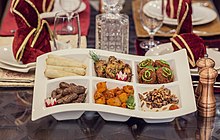

Arab cuisine uses specific and unique foods and spices. Some of those foods are:
- Meat—lamb and chicken are the most used, followed by beef and goat. Other poultry is used in some regions, and fish is used in coastal areas including the Mediterranean Sea, Atlantic Ocean and the Red Sea. Some Christian Arabs eat pork.[10]
- Dairy products—widely used, especially yogurt, buttermilk and white cheese. Butter and cream are also used extensively.
- Herbs and spices—amounts and types used generally varies from region to region.
- Herbs and spices include sesame, saffron, black pepper, allspice, turmeric, garlic, cumin, cinnamon, parsley, coriander and sumac.
- Spice mixtures include baharat, ras el hanout, za'atar, and harissa.
- Beverages—hot beverages are served more often than cold, coffee being at the top of the list in Middle-Eastern countries and tea at top in Maghreb countries.
- In Jordan, Palestinian culture, Egypt, some parts of Syria, Morocco, and Algeria, tea is much more prevalent as a beverage. Other Arabic drinks include Andalucian horchata and Maghrebi avocado smoothie.
- Grains—rice is the staple and is used for most dishes; wheat is the main source for bread. Bulgur and semolina are also used extensively.
- According to historic recipes known from Arabic cookbooks, grains were primarily used to make porridge and pasta type dishes in Arab cuisine until the 12th century. Two types of pasta were known: itriya, a short dry noodle of Greek origin similar to orzo, and rishta, a hand-cut fresh noodle of Persian origin.
- Legumes—lentils are widely used in all colours, as well as fava beans, peanuts, chickpeas (garbanzo beans), scarlet runner beans, green peas, lupini beans, white beans, and brown beans.
- Vegetables—popular vegetables in Arab cuisine include carrots, eggplant (aubergine), zucchini (courgette), artichokes, okra, onions, and olives. Potatoes are also eaten as vegetables in Arab culture.
- Fruits—pomegranate, dates, figs, oranges, citruses, watermelons, cantaloupe, honeydew melon, grapes, peaches, and nectarines are favored in Arab cuisine.
- Nuts—almonds, pine nuts, pistachios, and walnuts are often included in dishes or eaten as snacks.
- Greens—parsley, coriander and mint are popular as seasonings in many dishes, while spinach and mulukhiyah (leaves from the plant of the Corchorus genus) are used in cooked dishes.
- Dressings and sauces—the most popular dressings include various combinations of olive oil, lemon juice, parsley, or garlic, as well as tahini (sesame paste). Labaneh (strained yogurt) is often seasoned with mint, onion, or garlic, and served as a sauce with various dishes.
Structure of meals
There are two basic structures for meals in the Arab World, one regular schedule during most of the year and a second one that is unique to the month of Ramadan in which observant Muslims fast during the day.
Year-round
Breakfast
Cafés often serve croissants for breakfast. Breakfast is often a quick meal, consisting of bread and dairy products, with tea and sometimes jam. The most common breakfast items are labneh and cream (kishta, made of cow's milk).
Lunch
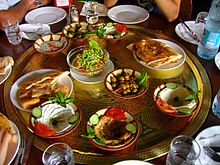
Lunch is considered the main meal of the day, and is traditionally eaten between 1:30 pm and 2:30 pm. It is the meal for which the family comes together. Rarely do meals have different courses; however, salads and mezze are served as side dishes to the main meal.
The platter usually consists of a portion of meat, poultry or fish, a portion of rice, lentils, bread and a portion of cooked vegetables, in addition to the fresh ones with the mezze and salad.
The vegetables and meat are usually cooked together in a sauce (often tomato, although others are also popular) to make maraqa, which is served with rice. Most households add bread.

Drinks are not necessarily served with the food; however, there is a very wide variety of drinks such as shineena (or laban), karakaden, Naqe'e Al Zabib, Irq Soos, Tamr Hindi, and fruit juice, as well as other traditional Arabic drinks.
During the 20th century, carbonated soda and fruit-based drinks have also become very popular.
Dinner
Dinner is traditionally the lightest meal, although in modern times, dinner has become more important with regards to entertaining guests due to the hours of the workday.
Ramadan
Iftar
Iftar (also called Futuur), or fast-breaking, is the meal taken at dusk when the fast is over. The meal consists of three courses: first, diners eat a date due to Islamic tradition.
This is followed by a soup or anything they would like, the most popular being lentil soup, but a wide variety of soups such as chicken, oats, freeka (a soup made from whole wheat and chicken broth), potato, maash, and others are also offered.

The third course is the main dish, usually eaten after an interval, when Maghreb prayer is conducted. The main dish is mostly similar to what is served in lunch year-round, except that cold drinks are served.
Suhur
Suhur is the meal eaten just before dawn, when fasting must begin. It is eaten to help the person make it through the day with enough energy until dusk.
Sweets
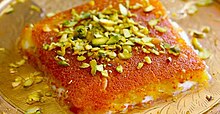
In addition to the two meals eaten during Ramadan (one for dinner and one for Suhur before dawn), sweets are consumed much more than usual during the month of Ramadan; sweets and fresh fruits are served between these two meals. Although most sweets are made all year-round such as kanafeh, baklava, and basbousa, some are made especially for Ramadan, such as qatayef.[12]
Arab hospitality
This section needs additional citations for verification. (July 2020) |
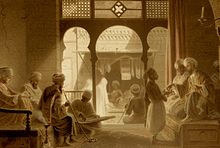
Essential to any cooking in the Arab world is the concept of hospitality and generosity. Meals are generally large family affairs, with much sharing and a great deal of warmth over the dinner table. Formal dinners and celebrations generally involve large quantities of lamb, and every occasion entails large quantities of Arabic coffee or Arabic tea.

Khaleej
Coffee ceremony
In the Khaleej al-Arab region, a visitor is greeted by a great table of dried fruits, fresh fruits, nuts and cakes with syrup. Dried fruits include figs, dates, apricots and plums. Fresh fruits include citruses, melons and pomegranate. Arabic coffee is most favored, but Arabic tea is also a great refresher. Spices are often added to the coffee and other drinks.

Guests dinner
In the Khaleej al-Arab region, a guest should expect a dinner consisting of a very large platter called Kabsa, shared commonly, with a large amount of spiced rice, with spicy lamb, chicken, or both, as separate dishes, with various stewed vegetables, heavily spiced, sometimes with a tomato-based sauce.
Different types of bread are served with toppings specific to the region. Tea would certainly accompany the meal, as it is almost constantly consumed. Coffee would also be served.

Maghreb
Tea/coffee ceremony
In the Maghreb region, a visitor will find a table full of bread-like snacks, including m’semen, baghrir, and other stuffed breads. These are served with honey, rosewater or olive oil.
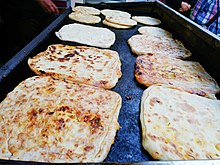
There are also many different cookies and cakes included accompanied by plates with different kinds of nuts. Mint tea is often served with it in a traditional Maghrebian teapot.
Dinner guests
In the Maghreb region, a guest may find a table with different kinds of stews, called marqas or tajines. Dishes such as couscous and other semolina-based foods are also to be found.
These main dishes are accompanied by smaller mezze-like plates with salads, sauces and dips. Breads such as m'semen, khobz and baguette are used to eat the stews.

Levantine
Coffee/tea ceremonyedit
In an average Arab Levantine household, a visitor might expect a table full of mezzes, breads topped with spices including za'atar and nuts. In the Levant, Arabic coffee is a much-loved beverage, but Arabic tea is also much enjoyed in Jordan and Palestinian culture.
Dinner guestsedit
In the Levant, a guest will find a table with different kinds of mezzes, nuts, dips and oils. Mezzes include hummus, baba ghanoush, falafel, kibbeh, kafta, smoked vegetables and tabouli salads. The nuts can differ from almonds to walnuts, with different spice coatings. The dips and oils include hummus and olive oil.

Regional differencesedit
There are many regional differences in the Arab cuisine. For instance, mujadara in Syria and Lebanon is different from mujadara in Jordan and Palestinian culture. Some dishes, such as mansaf (the national dish of Jordan), are native to certain countries and rarely, if ever, make an appearance in other countries.
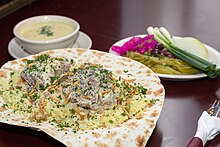
Unlike most Western recipes, cinnamon is used in meat dishes, as well as in sweets such as baklava. Dishes such as tajine and couscous can differ from Morocco to Libya, each having their own unique preparation. Other dishes, such as the Andalucian-Moorish bastilla and albondigas have different traditional spice mixes and fillings.

Many Arabic food words are borrowed from Aramaic, the language originally spoken by the indigenous Christian inhabitants of Iraq and Syria.[11]
Regional Arab cuisinesedit
Arabian Peninsulaedit
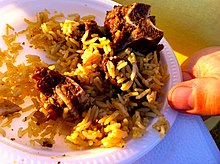

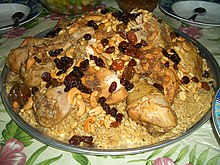
South Arabian and Eastern Arabian cuisine today is the result of a combination of diverse influences, incorporating Levantine and Yemeni cuisines.[13]
Bukhari rice (رز بخاري) (Ruz al Bukhari) is a very popular dish eaten in the Hejaz region of Saudi Arabia. It is made with spicy tomato sauce, flavoured chicken and a fresh salad.
Zdroj:https://en.wikipedia.org?pojem=Arab_cuisine
Text je dostupný za podmienok Creative Commons Attribution/Share-Alike License 3.0 Unported; prípadne za ďalších podmienok. Podrobnejšie informácie nájdete na stránke Podmienky použitia.
Antropológia
Aplikované vedy
Bibliometria
Dejiny vedy
Encyklopédie
Filozofia vedy
Forenzné vedy
Humanitné vedy
Knižničná veda
Kryogenika
Kryptológia
Kulturológia
Literárna veda
Medzidisciplinárne oblasti
Metódy kvantitatívnej analýzy
Metavedy
Metodika
Text je dostupný za podmienok Creative
Commons Attribution/Share-Alike License 3.0 Unported; prípadne za ďalších
podmienok.
Podrobnejšie informácie nájdete na stránke Podmienky
použitia.
www.astronomia.sk | www.biologia.sk | www.botanika.sk | www.dejiny.sk | www.economy.sk | www.elektrotechnika.sk | www.estetika.sk | www.farmakologia.sk | www.filozofia.sk | Fyzika | www.futurologia.sk | www.genetika.sk | www.chemia.sk | www.lingvistika.sk | www.politologia.sk | www.psychologia.sk | www.sexuologia.sk | www.sociologia.sk | www.veda.sk I www.zoologia.sk
